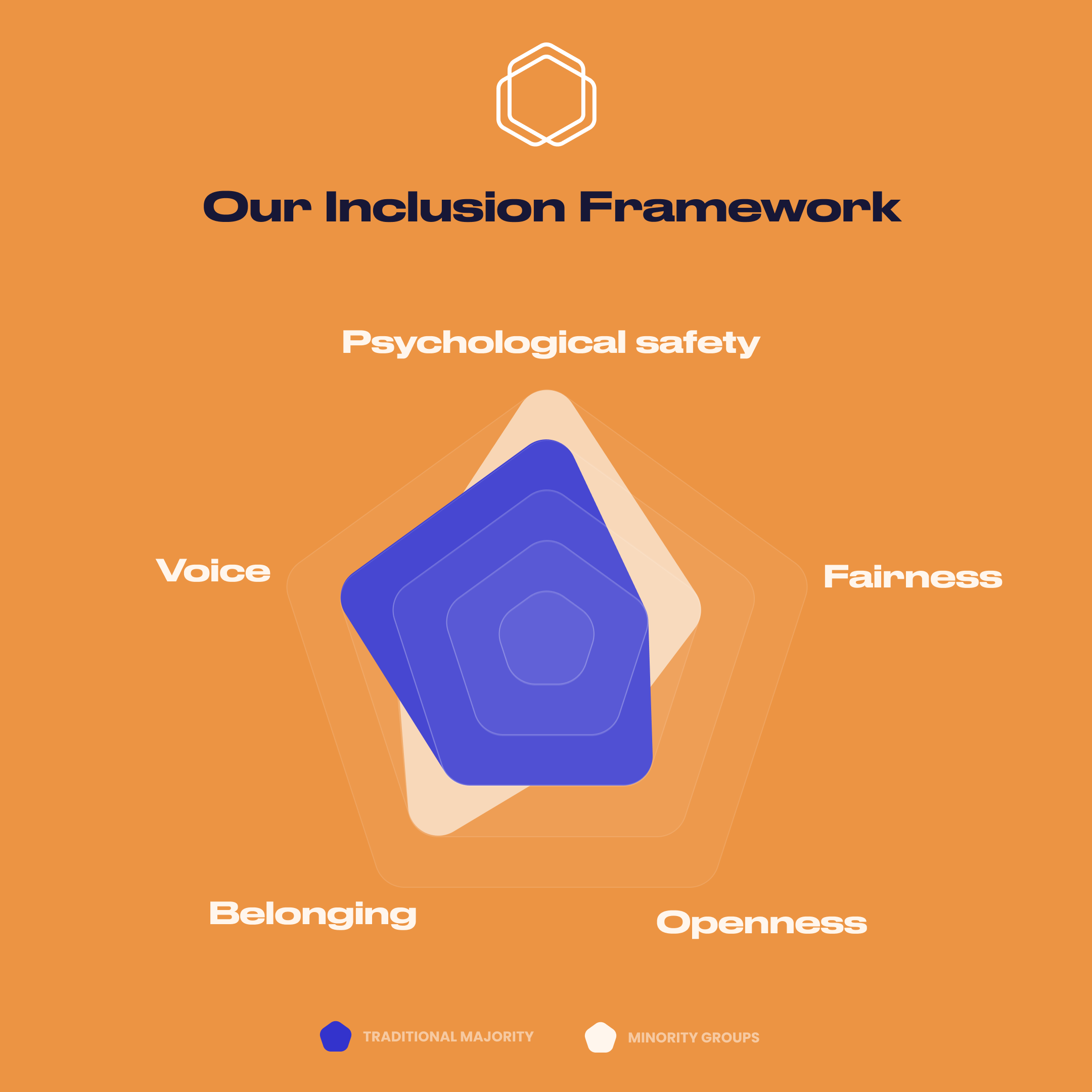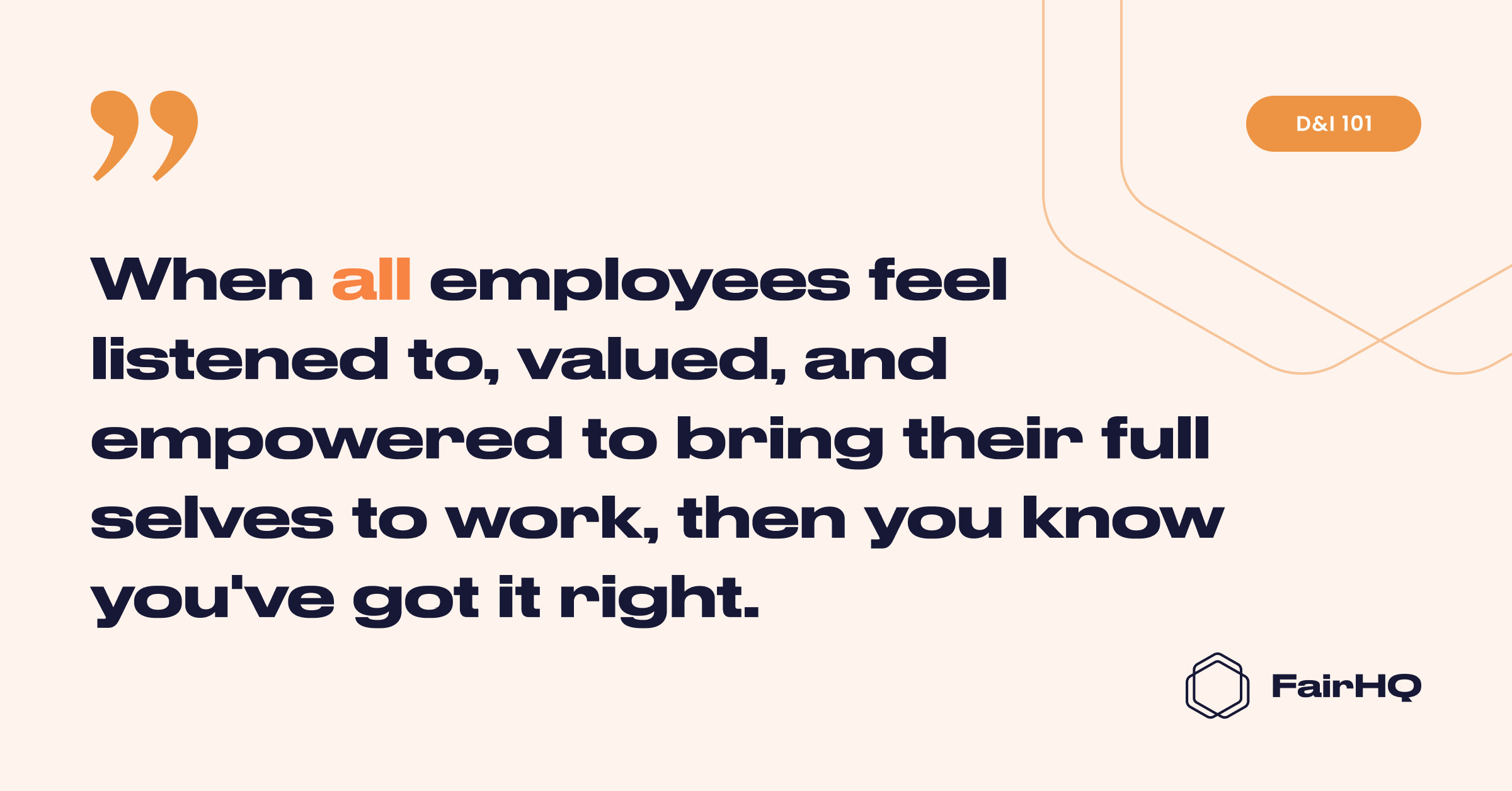What is inclusion and why is it important?

It’s hard to pin down exactly what makes a workplace inclusive. We all have different needs and desires — a welcoming environment feels very different from person to person. Ultimately, inclusion comes down to embracing diversity. When people feel safe being their authentic, unique selves but still part of a cohesive whole, then you’ve got it right. And one thing’s for certain — everyone wants to work for an inclusive company. Here’s why you need to nurture an inclusive work environment, and how to get started.
What is inclusion in the workplace?
There’s a reason you so often hear ‘diversity and inclusion’ in the same sentence. You can’t – or shouldn’t – have one without the other.
While diversity is about building a mix of people, inclusion is all about welcoming and valuing their diverse knowledge, perspectives and ideas.
It’s hard to define exactly what inclusion feels like, but when all employees feel listened to, valued, and empowered to bring their full selves to work (especially those from underrepresented backgrounds), then you know you’ve got it right.
There’s science behind what makes an inclusive environment. Two key components of inclusion are belonging and uniqueness.
- We humans have a natural desire to feel like accepted members of the group. In fact, feeling excluded triggers the exact same neural circuit as physical pain. In other words: social exclusion really hurts.
- At the same time, we also feel the need to show our distinctive colours, even if that doesn’t fit the norm.
You need both of the above to experience true inclusion.
Imagine someone called Bea, who feels she needs to laugh about sexist jokes to be accepted by her colleagues as ‘one of them’.
Or Jay, who is non-binary, but doesn’t feel like their colleagues make an effort to use their correct pronouns. Being accepted as part of the group while not being able to express our uniqueness isn’t true inclusion, and neither is the other way around.
When we feel that we can safely, confidently express our uniqueness and that our differences are respected and valued by our team, then we feel a sense of inclusion. We also know what happens in environments that aren’t inclusive: often people from underrepresented minority groups would spend a lot of mental effort not being themselves, which – frankly – is exhausting.
At Fair HQ, we’ve built a framework of 5 key dimensions of inclusion: psychological safety, belonging, openness, fairness and voice.

If your people feel welcomed by their peers and leaders, feel able to speak their minds and have their contributions are valued, then kudos to you! You’ve nurtured an inclusive working culture.

Why is inclusion important?
Inclusion is the key to harnessing the power of diversity. Our previous post “What is diversity?” outlined the undeniable benefits of welcoming diverse people to your team. But diversity isn’t a silver bullet. Without inclusion, diverse teams can suffer from interpersonal conflict (and lower financial returns!).
Did you know? Inclusion is a top priority for today’s job seekers. 80% of workers believe that inclusion is important when choosing an employer.
What’s more, research by Harvard scientists, Bohnet and Chilazi, shows that minorities group members:
- Have a higher bar set for them at work — they need to prove more to gain recognition from their peers.
- Are often treated as symbols of diversity without being truly valued as individuals.
- Are likely to be singled out as if they represent all members of their group.
Too often, diversity is thought of as a tick-box exercise — you hire one woman or person from an underrepresented ethnic background, and that’s all there is to it. This attitude isn’t just misguided, it’s actively damaging to minority groups.
Imagine there is only one woman of colour on your development team, Kylie. She’s often pulled into photoshoots to appear in recruitment materials, even with teams she never works with. Despite Kylie’s excellent track record, she somehow never reaches the top of the scale on performance reviews.
The feedback she receives is typically vague and unconstructive, such as “Kylie needs to improve her communication style.” Well, how exactly? Her manager even asks her to weigh in on contentious topics to understand “how Black people feel about this issue,” as if she understands every Black person’s experience.
This is a snapshot of how ‘tokenism’ plays out in the workplace, which has a whole host of knock-on effects, from lower motivation to reduced career aspirations.
People need to value and seek out different viewpoints in a constructive way. To really make the most out of the complementary expertise on your diverse team, you need to make minority group employees feel like fully valued team members.
How do I create an inclusive company?
There’s no simple handbook or easy fix to fostering an inclusive company. The behaviours of everybody shape your company culture and you’ll need a continuous, all-encompassing approach to shift your norms. So, as a leader, what can you do to foster inclusion?
There are plenty of behaviours you can embed in your team. And change always comes from the top, so make sure you practice inclusive behaviours yourself. Here are a few examples of changes you can make today:
- Talk about the importance of building an inclusive workplace, and link it up clearly with the actions you’re taking as a team. Clear communication from the top is paramount!
- Set the habit of regular and meaningful 1-to-1 meetings between employees and direct managers so that everyone gets the support they need.
- Ask for employees’ input in strategic business decisions to empower their upward voice.
- Systematically keep track of work allocation to make sure that essential team tasks (such as booking meeting rooms, taking notes and organising office parties) are distributed fairly.
Inclusion isn’t just about your everyday interactions though. You also need to have structures in place that guarantee fair and equal treatment to everyone. When employees feel that they have equal access to recognition, information and opportunities, they feel more trust and ownership. To bring this alive, you’ll need to embed transparent structures in everything you do.
How do I know if my company is inclusive?
It’s important to ask employees about their experiences at work to understand if any groups feel less supported or valued. It’s not enough to just look at the overall scores though, you need to pay attention to the experience gaps between groups.
Minority groups may have a totally different experience than the traditional majority who are represented in strong numbers in the world of work — white, heterosexual men.
Understanding where these gaps show up will enable you to develop a targeted strategy to resolve them. By embedding solutions that answer employees’ concerns, you can build a truly inclusive workplace.
At Fair HQ, we’ve developed a scientifically validated employee survey to give companies the fullest picture of how their employees perceive work culture and processes. Our tool gives you access to insights across 5 dimensions of inclusion, highlighting where you excel, what needs to improve, and the gaps in experience between groups.
Sounds like the solution for you?
Book a demoNow you understand what people are talking about when they talk about D&I. Great, but you might be wondering where to actually get started making a change. Company culture can be hard to shift. Embedding equitable and transparent processes can set you on the road towards an inclusive workplace.
Our next post has all the answers — stay tuned.
Backing it up
Bohnet, I. & Chilazi, S. (2020) ‘Chapter 5: Overcoming the Small-N Problem’ in What works? Evidence-Based Ideas to Increase Diversity, Equity, and Inclusion in the Workplace, University of Massachusetts Amherst, Center for Employment Equality
Casad, B. J., & Bryant, W. J. (2016). Addressing stereotype threat is critical to diversity and inclusion in organizational psychology. Frontiers in Psychology, 7, 8.Chicago
Chung, B. G., Ehrhart, K. H., Shore, L. M., Randel, A. E., Dean, M. A., & Kedharnath, U. (2020). Work group inclusion: Test of a scale and model. Group & Organization Management, 45(1), 75-102.Chicago
DeHaas, D L. et al. (2017) ‘Unleashing the power of inclusion‘ Deloitte
Leroy, H., Buengeler, C., Veestraeten, M., Shemla, M., & J. Hoever, I. (2021). Fostering Team Creativity Through Team-Focused Inclusion: The Role of Leader Harvesting the Benefits of Diversity and Cultivating Value-In-Diversity Beliefs. Group & Organization Management, 10596011211009683.Chicago
Benjamin, D. & Komlos, D. (2021) ‘How To Create A Culture Of Both Belonging And Uniqueness‘ Forbes